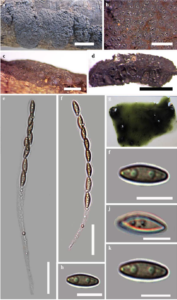Annulohypoxylon leptascum (Speg.) Y.M. Ju., et al., Mycologia 97(4): 859 (2005).
Index Fungorum number: IF 500310, Facesoffunginumber: FoF00296.
Isotype – BPI 738677
Saprobic on corticated and decorticated wood. Sexual morph Ascostromata 0.5–8 × 0.5–1.2 × 0.06–0.13 cm (x̄ = 4 × 0.8 × 0.08 cm), pulvinate to effuse-pulvinate, with inconspicuous perithecial mounds, surface sepia (63), dark brick (60), or fuscous (103); blackish granules immediately beneath surface and between perithecia, with KOH-extractable pigments greenish-olivaceous (90), dull green (70), or dark green (21); the tissue below the perithecial layer inconspicuous, perithecia 0.3–0.5 diam. × 0.3–0.7 mm high (x̄ = 0.4 × 0.5 mm), immersed, obovoid to tubular, ostioles conical-papillate, encircled with a convex truncatum-type disc 0.2–0.3 mm (x=0.3 mm) diam., paraphyses not seen. Asci (120–)125– 160(–167) × (3.8–)4–5.5(–5.8) μm (x̄ = 147 × 4.5 μm, n = 20), 8-spored, unitunicate, cylindrical, pedicellate, apical ring bluing in Melzer’s reagent, discoid, 0.5 × 1.5–2 μm (x̄ = 0.5 × 1.8 μm, n = 20). Ascospores (7.2–)7.5–13.8(–14) × (3.6–)4–6(–6.2) μm (x̄ = 9.7 × 5.5 μm, n = 30), uniseriate, one-celled, ellipsoid, inequilateral, with narrowly rounded ends, pale brown, with straight germ slit much less than spore-length and originating from one end, perispore indehiscent in 10 % KOH, epispore smooth. Asexual morph Reported by Ju and Rogers (1996), found on the surface of young stromata on natural substrates, Conidiogenous structures periconiella-like, dark brown, coarsely roughened. Conidiogenous cells pale brown, smooth to finely roughened. Conidia hyaline, smoothwalled, ellipsoid.
Culture characters – Colonies on OA at 25–28 °C reaching the edge of 6 cm in 7 days, whitish, velvety to felty, azonate, with diffuse margins, reverse at first yellow green (71) and turning greenish-olivaceous (90) in the centre after 5–7 days.
Material examined – BRAZIL, Apiahy, on wood, 1888, Puiggari (BPI 738677, isotype); THAILAND, Chiang Mai, Doi Inthanon, on decaying wood, 3 December 2012, D.A. Daranagama and K.D. Hyde AXL 036 (MFLU 13–0118), living cultures, MFLUCC 12–0829, ICMP).
Notes – Annulohypoxylon leptascum and A. truncatum are the potential taxa that could be compared with this specimen. Both these taxa share common stromatal characters with KOH extractable pigments. The inconspicuous tissue below the perithecial layer in the specimen is a feature similar to A. leptascum. The perithecia are obovoid as in A. leptascum. Even with slight deviations in sizes, the asci and ascospores are quite similar to that of A. leptascum. The ascus apical ring was however not observed as mentioned in the description of A. leptascum (Ju and Rogers 1996). Annulohypoxylon elevatidiscus reported in Taiwan and described in Ju et al. (2004) is also a possible match with our specimen. It has similar stromatal characters except for the conspicuous tissue layer beneath perithecia. However, A. elevatidiscus has large, sphaerical perithecia compared with this specimen. In addition, the dehiscent perispore in KOH was not observed in this specimen. Annulohypoxylon leptascum has so far been reported only from temperate countries and hence recorded for the first time from Thailand with the new molecular data.

Fig. 1 Annulohypoxylon leptascum (MFLU 13–0118). a Stromatal habit in wood b Ostioles seen from above c Stroma inside view d Cross section of the stroma showing perithecia e Pigment formation in KOH f, g Mature ascus in water h, i Ascospore in water j Ascospore showing germ slit k Dehiscent perispore in KOH. Scale bars: a-c=5 mm, d=1 mm, f–k=10μm.
